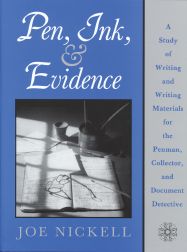New Castle: Oak Knoll Press, 2003. small 4to. stiff paper wrappers. x, 228 pages. First edition, third printing with corrections. An excellent study of writing and writing materials for the penman, collector, and document detective. The author traces the development of writing and writing materials from the ancient cuneiform tablet to today's historical documents. This work is essential for all calligraphers, archivists, literary historians and document examiners. Over one hundred illustrations. READ MORE
Price:
$29.95
other currencies
Order nr. 71215
The Quill
Much ancient writing was done without benefit of the pen: The Babylonians impressed their cuneiform characters in clay tablets with a wedge-shaped instrument; the Greeks and Romans chiseled inscriptions on stone monuments and wrote with a stylus on wax-coated tablets; and the Chinese used the brush for their calligraphy, as did the Egyptians for their early hieroglyphics.
The same rush stem which the Egyptians frayed to make a brush, however, was later fashioned into a crisply cut writing instrument. This reed pen was used with a soot-and-glue ink, first on a writing material made from another type of reed, called papyrus, and subsequently (in Greece and Rome) on parchment.
Because it was more readily available in western Europe, the quill eventually displaced the reed pen (although the latter survived for certain specific uses, such as large lettering).2 According to one authority, "It appears safe to assume that the quill pen came into gradual use with the establishment of Roman formal capital letters, of graduated thick and thin strokes, and the supplanting of papyrus by vellum [parchment] about 190 B.C."
Nevertheless, certain reference to the quill is not found before the early seventh century, when a specific passage occurs in the writings of Saint Isidore of Seville. Dated 624, it refers to penna avis (bird feather) used for Instrumenta scribae (scribes' implements). In- deed, the Latin for "feather," penna, is the source for our English word "pen." The equivalent terms for this writing instrument in France and Germany have a similar derivation, being plume and feder, respectively.
Quill Selection
The feathers of choice were typically those of the goose, the most common of domestic fowls. Holland was a major European supplier, and-since it was often claimed the best quills came from the coldest climates-bales of them were imported into England during the eighteenth and nineteenth centuries from such additional countries as Norway, Iceland, and Greenland. Black goose quills from Hudson Bay were prized for over a century, and Ireland was also a supplier of quills, as shown by a Kentucky Gazette advertisement of 1818 announcing for sale "A few Thousand Superior Irish Quills."
In England itself, quality quills from the county of Lincolnshire were especially plentiful. As Isaac Taylor wrote in 1823 in his Scenes of British Wealth, great flocks of up to ten thousand were driven from Lincolnshire to London. "But we have not done with the pens and the geese there. Their feathers and quills are so valuable that the avarice of man has put aside his better feelings; the geese do not live in peace until they die, and know nothing more about it; but, about the end of March, they have their quill [i.e., wing] feathers pulled out to make pens, and their other feathers also."
In addition to geese, however, swans and turkeys also supplied feathers for pens, as did, occasionally, pheasants and ravens. In medieval times mention was even made of pelican and peacock quills. Crow quills were often preferred for fine pen drawing as well as for the tiny handwriting sometimes affected by ladies (fig. 1.1). In fact, as an 1846 tract on penmanship summed up, in couplet form: "From the great Eagle to the Wren, / We may pluck quills that make a pen.”

